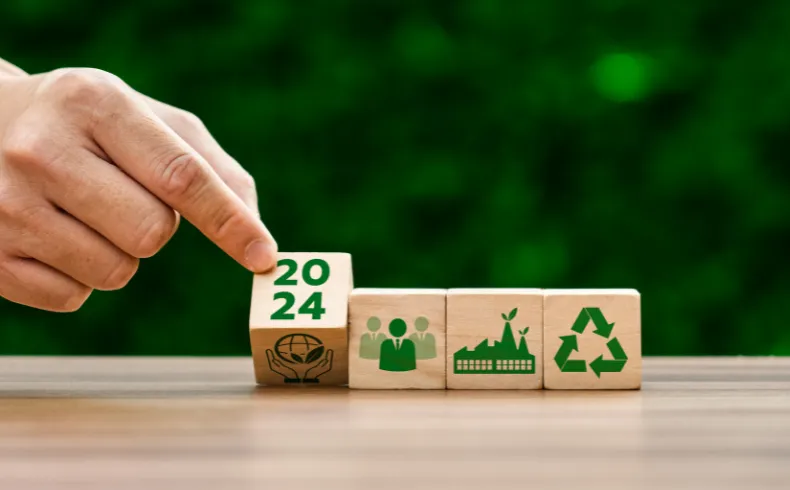Severe storms, wildfires, droughts, floods – the accelerating impacts of climate change pose an existential threat to businesses worldwide. Continuing with business as usual is no longer an option.
Fortunately, innovative climate resilience and sustainability strategies are rapidly emerging to help organizations brace for escalating climate risks.
From leveraging AI to forging new cross-industry partnerships, companies are getting proactive about preparedness. Here are three cutting-edge climate resilience and sustainability approaches leading the charge.
AI-Powered Climate Risk Analytics
The first line of resilience is understanding your specific climate exposure risks. That’s where AI-powered analytics comes in.
By integrating artificial intelligence, big data, and advanced modeling capabilities, companies can run sophisticated climate scenario analyses tailored to their operations, supply chains, and asset footprints.
This data-driven approach identifies critical vulnerabilities, quantifies potential losses from climate impacts like sea level rise or heat waves, and pinpoints the highest priorities for investing in resilience measures.
Industry leaders like Microsoft are using this AI-enabled climate intelligence to future-proof their businesses.
According to Lucas Joppa, Microsoft’s Chief Environmental Officer, “By taking a clear-eyed look at our climate risks through advanced data modeling, we can make smarter decisions about resilience strategies that harden our infrastructure and ensure long-term business continuity”.
Corporate Climate Resilience Coalitions
Climate change is a world-scale challenge that demands collaboration across companies and sectors.
That’s driving the rise of climate resilience coalitions – groups of businesses joining forces to drive resilience progress faster collectively.
Major coalitions like the Resilience Rising consortium allow companies to share best practices, set industry standards, and benchmark their resilience efforts against peers. This cross-pollination of knowledge accelerates resilience while avoiding firms having to reinvent the wheel individually.
Consumer products giant Unilever is an active participant, implementing resilience actions through these coalitions.
“We’ve taken steps like rerouting critical distribution operations to circumvent high climate risk regions”, said Michelle Grennan, Unilever VP of Resilience”. Collaborating with other members provides that external perspective that challenges our assumptions and pushes our resilience thinking further”.
Climate Resilience Finance Solutions
Building climate resilience and sustainability requires significant capital investment – but new finance vehicles are emerging to fund these projects. Green bonds that raise capital for environmental solutions like coastal defenses are growing in popularity.
More targeted climate resilience bonds and resilience investment funds are hitting the market too.
Additionally, innovative insurance products are evolving to safeguard companies from escalating climate risks. Parametric insurance policies pay out automatically once pre-defined climate impact thresholds are exceeded, rapidly injecting capital when disasters strike.
With global annual climate resilience investment needs projected to hit $90 billion by 2030, growth in these finance solutions is expected to accelerate rapidly in the coming years.
By leveraging instruments like resilience bonds and climate risk insurance, companies can unlock funding for resilience while transferring residual risks.
Climate-Resilient Design and Engineering
As climate hazards intensify, companies are rethinking how they design and construct critical infrastructure and assets from the ground up.
The emerging discipline of climate-resilient design and engineering factors in projected climate impacts like extreme heat, flooding, or high winds to develop standards and protocols that “harden” the built environment.
For example, in coastal regions, this means constructing new facilities using materials and elevation levels to withstand rising sea levels and storm surges.
It can also integrate natural ecosystem buffers like mangrove forests into the design. Leading engineering firms are developing cutting-edge resilient design tools and work with companies to assess climate risks to existing assets and retrofit accordingly.
“We can’t just design for historical climate conditions anymore – that’s the mindset that needs disrupting”, said Colin Lalor, Director of Resilience at engineering consultancy EXP”.
“Our teams analyze multiple climate hazard scenarios to plan protective measures whether it’s elevating a new factory site or reinforcing the roof capabilities on a warehouse to withstand higher wind speeds”.
Closing Thoughts on Climate Resilience and Sustainability
The disruptive force of climate change is here – achieving true business resilience against its effects is now a strategic imperative for any organization hoping to endure long-term.
While the above-mentioned approaches represent the cutting-edge today, the resilience innovation pipeline will only intensify as climate risks grow.
Proactively boosting adaptive capacity through emerging best practices and solutions is crucial. Companies must make climate resilience and sustainability a core business strategy and operational decision-making driver.
Those who get ahead of the curve will be better positioned to withstand escalating climate impacts while their stuck-in-neutral peers falter. In this new reality, resilience is the pathway to continued sustainability and growth.



